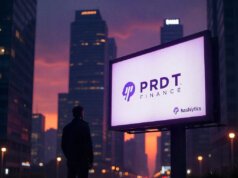Robinhood has expanded its blockchain tokenization initiative for European users, adding nearly 500 tokenized US stocks and exchange-traded funds (ETFs) on the Arbitrum network. The total value of these blockchain-based assets now exceeds $8.5 million, showing a growing interest in real-world asset trading on decentralized platforms. This move underscores the increasing adoption of blockchain technology in traditional finance, offering retail investors new avenues for accessing global markets.
Overview of Tokenized Assets
Robinhood has issued 493 tokenized assets on Arbitrum, valued at over $8.5 million. Around 70% are US stocks and 24% are ETFs. The Bank of Lithuania has requested details on the token structure, while Robinhood’s tokens trade 24/7 starting from 1 euro under MiFID II rules. The availability of these tokenized assets allows European users to engage with US equities and ETFs outside of traditional market hours, providing greater flexibility and accessibility.
The composition of the tokenized assets reflects a diverse range of investment opportunities. The majority being US stocks provides exposure to some of the world’s largest and most influential companies. The inclusion of ETFs further diversifies the offerings, allowing investors to gain exposure to broader market segments or specific investment themes, such as technology, healthcare, or emerging markets. This diversification is crucial for managing risk and achieving long-term investment goals.
The fact that the Bank of Lithuania has requested details on the token structure highlights the regulatory scrutiny surrounding tokenized assets. Regulators are keen to understand the risks and benefits associated with these new financial instruments, and to ensure that investors are adequately protected. Robinhood’s compliance with MiFID II rules, which govern financial markets in the European Union, demonstrates its commitment to operating within a regulated framework.
Trading Activity and Market Traction
Data from Dune Analytics indicates that Robinhood’s tokenized assets on Arbitrum are gaining traction. The brokerage recently added around 80 new tokens, enhancing both variety and trading activity. The total mint volume has reached $19.3 million, with burning activity at $11.5 million, showing active circulation and redemption. Minting refers to the creation of new tokens, while burning involves permanently removing tokens from circulation. The difference between mint and burn volumes provides insight into the net demand for these tokenized assets.
The addition of new tokens, including companies like Galaxy (GLXY), Webull (BULL), and Synopsys (SNPS), broadens the appeal of the platform and attracts a wider range of investors. These companies represent diverse sectors, including financial services (Galaxy and Webull) and technology (Synopsys), further enhancing diversification opportunities. The increasing trading activity suggests that investors are becoming more comfortable with the concept of tokenized assets and are actively using the platform to manage their portfolios.
The Arbitrum Advantage
Robinhood’s choice of the Arbitrum network is also significant. Arbitrum is a Layer 2 scaling solution for Ethereum, designed to improve transaction speeds and reduce costs. By leveraging Arbitrum, Robinhood can offer a more efficient and cost-effective trading experience for its users. Layer 2 solutions are crucial for scaling blockchain applications and making them more accessible to a wider audience. The mint and burn volumes of $19.3 million and $11.5 million, respectively, demonstrate a healthy level of activity, indicating that users are actively engaging with the platform and managing their tokenized asset holdings.
Understanding Tokenization and Its Risks
Tokenization is the process of representing real-world assets, such as stocks, bonds, or real estate, as digital tokens on a blockchain. This process offers several potential benefits, including increased liquidity, fractional ownership, and greater accessibility. By tokenizing US stocks and ETFs, Robinhood is providing European users with the opportunity to invest in these assets without the need for traditional brokerage accounts or high minimum investment amounts.
However, it is important to understand the risks associated with tokenized assets. These risks can include regulatory uncertainty, security vulnerabilities, and the potential for fraud. Investors should carefully research the tokenized assets they are considering investing in and understand the underlying technology and legal framework.
Investor Guidance
The regulatory landscape for tokenized assets is constantly evolving. It is important for investors to stay informed about the latest regulatory developments and to understand how these developments may impact their investments. Consulting with a financial advisor can also be helpful, as a financial advisor can provide personalized advice based on an investor’s individual circumstances and risk tolerance. As tokenization continues to gain traction, it is essential for investors to approach this new asset class with caution and to conduct thorough due diligence before investing.
Key Recommendations
- Research the risks of tokenized assets thoroughly
- Stay informed about regulatory developments
- Consult with a financial advisor before investing





